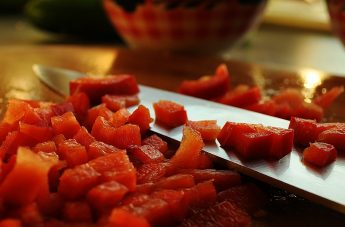Introduction
Quick Navigation
You know about the various kitchen knife brands, and you want to understandably purchase a knife set that comes from a reputable brand. You also want to invest in the type that fits your needs and wants. You know the differences between American, Japanese, and German knives, and you can easily research different brands such as Wusthof, Shun, and Dalstrong. You know about the stamped and forged knives and their differences.
However, there is one thing you also want to consider when looking for the right knife. You want to look into the type of steel that reputable knife brands use for their blades. You want to choose the type of steel that matches the expectations you have for your knife. Let’s now talk about the various common steel types for kitchen knives.
Cronodur 30 Stainless Steel
When you think of stainless steel, you think of a high-quality metal material which it is. However, there are differences in types of stainless steel, and one type is the Cronodur 30. This particular type of stainless steel consists of a little bit of nitrogen in addition to low carbon. The one great thing about this form of stainless steel is that it is a hard metal, and it is also corrosion-resistant.
Another name for this metal is the “Supersteel” because it is the material you find in premium knives. Therefore, this is a costly metal, and knives such as the Zwilling WIN 1731 set are more expensive for this reason. However, if you want the premium knife and have the budget to invest in it, this material makes one of the most high-end blades.
MC66 Stainless Powder Steel
Another type of stainless steel is the MC66 Stainless Powder Steel knife. This material consists of the highest alloy elements content for all powdered steel blades. The material is also extremely durable and hard. However, there is one thing to keep in mind about it, and that it is somewhat more brittle than many other steel blades. It is also not completely corrosion-resistant. Therefore, there can be some breakage associated with this knife. You may also have more difficulty when it comes to sharpening the blade with this material. You can expect lamination with this steel. It is still a good metal material. However, you do need to ensure extra care for it.
VG10 Stainless Steel
The VG10 Stainless Steel type is a premium metal that contains plenty of carbon which makes it very hard, and sharpening this knife is relatively easy. You can expect to have a razor-sharp feature with this metal, and it is also rust-resistant. However, ironically, even with this premium metal, it is not entirely corrosion-resistant, which means you have to give the knife with this metal more care. It has a higher sensitivity to pit corrosion than other stainless steel types that contain lower carbon, which is essential to remember.
The one thing to remember is to sharpen this blade regularly because that will help keep corrosion more at bay. You also never want to put these knives in the dishwasher as they are not dishwasher-safe, and you also don’t want to let them stay too long in the sink. The best way to care for this blade besides regular sharpening is to hand wash them after each use with mild dish soap and water, clean them with a clean cloth, and put them into the knife holder.
Aogami Or Blue Paper Steel
Aogami or blue paper steel is not stainless steel. The Japanese term Aogami means blue paper, named after the Hitachi paper wraps around the steel. It is a variation of white paper steel, which is pure steel that contains some alloy. Blue paper steel not only contains alloy, but it also has wolfram and chrome, and it is chip and corrosion-resistant even though it is not on the same level as stainless steel. You can sharpen them regularly, and they can provide a razor-sharp performance as well.
D2 Stainless Steel Powder
D2 is a stainless steel powder, which is also known as the SKD11, and it contains more alloy than other forms of stainless steel. That means the D2 is more rigid than other stainless steel powder blades. That is because it has less chrome than other forms of steel. However, because there is less chrome, this metal is also less rust-resistant. You want to ensure that you are taking proper care of the blade, so it does not begin to rust. The material involves lamination that the manufacturing process includes.
SG2 Stainless Powder Steel
The SG2 or SGPS stainless steel powder is very similar to its D2 counterpart. It contains more alloy than other stainless steel, and this powdered stainless steel is harder and more resistant to corrosion than D2. It is more rust-resistant than the D2 and the VG10 steel. Lamination is part of the manufacturing process like it is for other powdered stainless steel knives. Another good thing about this stainless steel variant is that it has high levels of scratch resistance, which means it will last a long time if you take good care of it.
X50CrMoV15 Stainless Steel
The X50CrMoV15 stainless steel blade is the most common one, and you see German manufacturers use this one often, such as Zwilling and Wusthof. That is because the X50CrMoV15 steel is highly rust-resistant as it contains high levels of chrome and carbon. It also contains smaller amounts of Vanadium and Molybdene, which helps it improve its durability and grain structure. Home cooks and professional cooks prefer to use knives with the X50CrMoV15 blade because it is strong, easy to use, and versatile. Additionally, it cuts well, and even though they need regular sharpening, they are easy to maintain.
Conclusion
When you look for knives for your kitchen, you will examine the different knife brands. You will want to explore and do some thorough research on brands of knives. However, it is also essential to learn about the different types of steel used in most knives. That means you will know what to expect in the performance, and you will also know how to care for the blade properly. Some knives are easy to maintain, and others require more work. All knives require sharpening, but some edges need frequent sharpening while others do not. After learning about what different blades can offer, you will have an easier time determining the right one for you.

